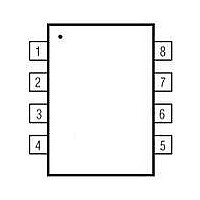MAXQ610A-0000+ Maxim Integrated Products, MAXQ610A-0000+ Datasheet - Page 12

MAXQ610A-0000+
Manufacturer Part Number
MAXQ610A-0000+
Description
IC MCU 16BIT 64K IR MOD 32TQFN
Manufacturer
Maxim Integrated Products
Series
MAXQ™r
Datasheets
1.MAXQ610A-0000.pdf
(28 pages)
2.MAXQ610A-0000.pdf
(29 pages)
3.MAXQ610A-0000.pdf
(23 pages)
Specifications of MAXQ610A-0000+
Core Processor
RISC
Core Size
16-Bit
Speed
12MHz
Connectivity
SPI, UART/USART
Peripherals
Brown-out Detect/Reset, Infrared, Power-Fail, POR, WDT
Number Of I /o
20
Program Memory Size
64KB (64K x 8)
Program Memory Type
FLASH
Ram Size
2K x 8
Voltage - Supply (vcc/vdd)
1.7 V ~ 3.6 V
Oscillator Type
Internal
Operating Temperature
0°C ~ 70°C
Package / Case
32-TQFN Exposed Pad
Processor Series
MAXQ610
Core
RISC
Data Bus Width
16 bit
Data Ram Size
2 KB
Interface Type
SPI, USART
Maximum Clock Frequency
12 MHz
Number Of Timers
4
Operating Supply Voltage
1.7 V to 3.6 V
Maximum Operating Temperature
+ 70 C
Mounting Style
SMD/SMT
Minimum Operating Temperature
0 C
Controller Family/series
MAXQ
No. Of I/o's
24
Ram Memory Size
2048Byte
Cpu Speed
12MHz
No. Of Timers
2
Embedded Interface Type
JTAG, SPI, USART
Rohs Compliant
Yes
Number Of Programmable I/os
32
Development Tools By Supplier
MAXQ610-KIT
Package
32TQFN EP
Family Name
MAXQ
Maximum Speed
12 MHz
Lead Free Status / RoHS Status
Lead free / RoHS Compliant
Eeprom Size
-
Data Converters
-
Lead Free Status / Rohs Status
Lead free / RoHS Compliant
Other names
90-M6800+B01
16-Bit Microcontroller with Infrared Module
Table 2. Watchdog Interrupt Timeout (Sysclk = 12MHz, CD[1:0] = 00)
The watchdog timer functions as the source of both the
watchdog-timer timeout and the watchdog-timer reset.
The timeout period can be programmed in a range of
2
ed when the timeout period expires if the interrupt is
enabled. All watchdog-timer resets follow the pro-
grammed interrupt timeouts by 512 system clock
cycles. If the watchdog timer is not restarted for another
full interval in this time period, a system reset occurs
when the reset timeout expires. See Table 2.
The dedicated IR timer/counter module simplifies low-
speed IR communication. The IR timer implements two
pins (IRTX and IRRX) for supporting IR transmit and
receive, respectively. The IRTX pin has no correspond-
ing port pin designation, so the standard PD, PO, and
PI port control status bits are not present. However, the
IRTX pin output can be manipulated high or low using
the PWCN.IRTXOUT and PWCN.IRTXOE bits when the
IR timer is not enabled (i.e., IREN = 0).
The IR timer is composed of two separate timing enti-
ties: a carrier generator and a carrier modulator. The
carrier generation module uses the 16-bit IR Carrier
register (IRCA) to define the high and low time of the
carrier through the IR carrier high byte (IRCAH) and IR
carrier low byte (IRCAL). The carrier modulator uses the
IR data bit (IRDATA) and IR Modulator Time register
(IRMT) to determine whether the carrier or the idle con-
dition is present on IRTX.
The IR timer is enabled when the IR enable bit (IREN) is
set to 1. The IR Value register (IRV) defines the begin-
ning value for the carrier modulator. During transmis-
sion, the IRV register is initially loaded with the IRMT
value and begins down counting towards 0000h,
whereas in receive mode it counts upward from the ini-
tial IRV register value. During the receive operation, the
IRV register can be configured to reload with 0000h
when capture occurs on detection of selected edges or
12
15
WD[1:0]
to 2
______________________________________________________________________________________
00
01
10
11
24
system clock cycles. An interrupt is generat-
IR Carrier Generation and
WATCHDOG CLOCK
Sysclk/2
Sysclk/2
Sysclk/2
Sysclk/2
Modulation Timer
15
18
21
24
WATCHDOG INTERRUPT TIMEOUT
174.7ms
can be allowed to continue free-running throughout the
receive operation. An overflow occurs when the IR timer
value rolls over from 0FFFFh to 0000h. The IR overflow
flag (IROV) is set to 1 and an interrupt is generated if
enabled (IRIE = 1).
The IRCAH byte defines the carrier high time in terms of
the number of IR input clocks, whereas the IRCAL byte
defines the carrier low time.
During transmission, the IRCA register is latched for
each IRV downcount interval and is sampled along with
the IRTXPOL and IRDATA bits at the beginning of each
new IRV downcount interval so that duty-cycle variation
and frequency shifting is possible from one interval to
the next, which is illustrated in Figure 1.
Figure 2 illustrates the basic carrier generation and its
path to the IRTX output pin. The IR transmit polarity bit
(IRTXPOL) defines the starting/idle state and the carrier
polarity of the IRTX pin when the IR timer is enabled.
During IR transmission (IRMODE = 1), the carrier gener-
ator creates the appropriate carrier waveform, while the
carrier modulator performs the modulation. The carrier
modulation can be performed as a function of carrier
cycles or IRCLK cycles dependent on the setting of the
IRCFME bit. When IRCFME = 0, the IRV downcounter is
clocked by the carrier frequency and thus the modula-
tion is a function of carrier cycles. When IRCFME = 1,
the IRV downcounter is clocked by IRCLK, allowing car-
rier modulation timing with IRCLK resolution.
21.9ms
Carrier Duty Cycle = (IRCAH + 1)/(IRCAH + IRCAL + 2)
2.7ms
1.4s
IR Input Clock (f
Carrier Frequency (f
Carrier High Time = IRCAH + 1
Carrier Low Time = IRCAL + 1
f
IRCLK
/(IRCAH + IRCAL + 2)
Carrier Generation Module
IRCLK
WATCHDOG INTERRUPT (μs)
WATCHDOG RESET AFTER
) = f
CARRIER
SYS
IR Transmission
42.7
42.7
42.7
42.7
/2
IRDIV[1:0]
) =












